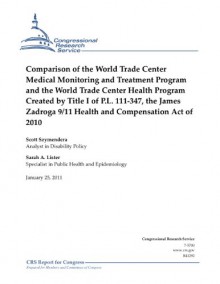Comparison of the World Trade Center Medical Monitoring and Treatment Program and the World Trade Center Health Program Created by Title I of P.L. 111-347
In the wake of the September 11, 2001, terrorist attacks, Congress passed appropriations to provide limited health screening and treatment services to persons involved in rescue, recovery, and cleanup operations around the former site of the World Trade Center. This program, now known as the...
show more
In the wake of the September 11, 2001, terrorist attacks, Congress passed appropriations to provide limited health screening and treatment services to persons involved in rescue, recovery, and cleanup operations around the former site of the World Trade Center. This program, now known as the World Trade Center (WTC) Medical Monitoring and Treatment Program (MMTP), is not authorized in statute but rather relies on discretionary appropriations to provide services to eligible individuals. Since its inception in FY2002, the MMTP has received approximately $475 million in federal funds, and over 57,000 responders and community members have met initial eligibility requirements for the program.On January 2, 2011, President Barack Obama signed into law P.L. 111-347, the James Zadroga 9/11 Health and Compensation Act of 2010. Title I of P.L. 111-347 replaces the MMTP with a program authorized in statute and financed through mandatory federal spending, partially matched by New York City. This program, called the World Trade Center Health Program (WTCHP), will provide full medical screening and treatment benefits to eligible WTC responders and community members beginning in July 2011. In addition, Title I of P.L. 111-347 establishes formal eligibility requirements based on a person’s activities after September 11, 2001, and his or her current health conditions. Health benefits will be provided by Clinical Centers of Excellence, a national network of providers, and the program will be administered by the Department of Health and Human Services (HHS).The WTCHP will sunset at the end of FY2016 or FY2015 if a federal spending cap is met. Total federal spending on the program is capped at $1.556 billion over the life of the program. New York City will contribute 10% of the program’s costs through FY2015, after which its contribution would become equal to one-ninth of any federal spending in FY2016. In addition to persons already receiving services under the MMTP, the WTCHP will serve up to 25,000 new responders and 25,000 new community members, referred to as survivors.
show less

